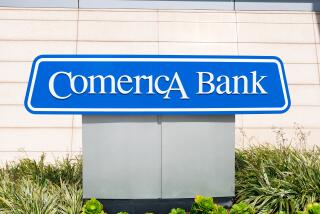Bank Bailout to Cost U.S. $2 Billion : FDIC Outlines Terms of Deal for Banc One to Save MCorp
- Share via
WASHINGTON — The Federal Deposit Insurance Corp. disclosed details Thursday of the complex arrangement under which Banc One Corp. of Columbus, Ohio, won a bidding competition to take over 20 failed banks of MCorp of Dallas, a bailout that will cost the federal government about $2 billion and constitute the second-largest bank rescue ever.
FDIC Chairman L. William Seidman, describing the arrangement worked out in principle a day earlier, said the FDIC share would involve $300 million in cash outlays and an additional $1.7 billion debt to the Federal Reserve. It is part of a rescue package that includes from $3 billion to $3.5 billion in bad debts that are to be transferred to a separate asset pool, marked down to current market value and liquidated.
“We have the flexibility to forgive all of that” $2 billion, Seidman said. He said the eventual cost could range as much as 15% higher or lower, depending on the outcome of the liquidation, which is expected to take up to five years.
He said the 1984 bailout of Continental Illinois Corp., which originally involved an FDIC assumption of about $3.5 billion in bad debts, is now estimated to have reduced the aggregate loss to $1.5 billion. That operation, unprecedented at the time, is now ranked as only the third most costly bank bailout, after the $3-billion First Republic Bancorp rescue and now that of MCorp.
Terms of Transaction
Under the arrangement announced Thursday, Banc One is to put up $500 million in new capital immediately, most of it in a $462.5-million loan to FDIC, which in turn would acquire outstanding non-voting stock in the MCorp banks and assume the risk of ownership of 92.5% of the failed holding company’s equity for five years.
Banc One is to acquire the remaining equity, in the form of Class A voting stock, for $37.5 million in cash and will assume ownership of the remaining assets in prescribed stages by the fifth anniversary of the deal being finalized.
Seidman said Banc One won out over five other bidders: Wells Fargo & Co. of San Francisco; NCNB Corp. of Charlotte, N.C.; Chemical Banking Corp. of New York; First City Bancorp of Houston, and the leveraged buyout firm of Kohlberg Kravis Roberts & Co. of New York.
NCNB is already a partner with FDIC in the bailout last year of First Republic Bank of Dallas. That, Seidman said, was--by FDIC policy--”not a positive factor” and weighed against the North Carolina holding company in the decision to award the MCorp deal to a competitor.
Seidman said Banc One did not demand any tax breaks to sweeten the deal and that FDIC did not offer any. In the First Republic bailout, which at a currently estimated federal cost of $3 billion is the largest bank rescue ever, NCNB acquired tax benefits estimated at nearly $3 billion.
Out in 5 Years
The present arrangement, whose complex feature of Banc One lending most of the stake to FDIC, receiving gradual forgiveness of the loan, then paying an added $10 million risk premium to the federal agency, was tailored by Banc One for internal accounting reasons, Seidman said, “because they believed that for market reasons it would favor them.”
He added that the deal equally suits his agency. “The FDIC will be out totally in five years,” Seidman said. The bottom line, he added, is that “for bank regulatory purposes this will be consolidation” of MCorp’s 20 Texas banks under ownership and eventual management of Banc One.
As a practical matter, the $500 million Banc One intends to put up in cash and in the form of the $462.5-million loan to FDIC, will count as an immediate capital infusion to MCorp, which has been reorganized since it was seized by the government last March and has operated under the temporary name of Deposit Insurance Bridge Bank, Dallas.
The assets of the 20 MCorp banks, estimated at $13 billion, include bad loans, real estate investments that soured and other troubled assets estimated at $3 billion to $3.5 billion. These are to be pooled separately and liquidated.
“For practical purposes,” Seidman said, “we will own the bad loans, and we intend to renegotiate them at the end of the five years if they have not been liquidated by then. We estimate the loss to be within 10% or 15% of $2 billion.”
More to Read
Inside the business of entertainment
The Wide Shot brings you news, analysis and insights on everything from streaming wars to production — and what it all means for the future.
You may occasionally receive promotional content from the Los Angeles Times.










